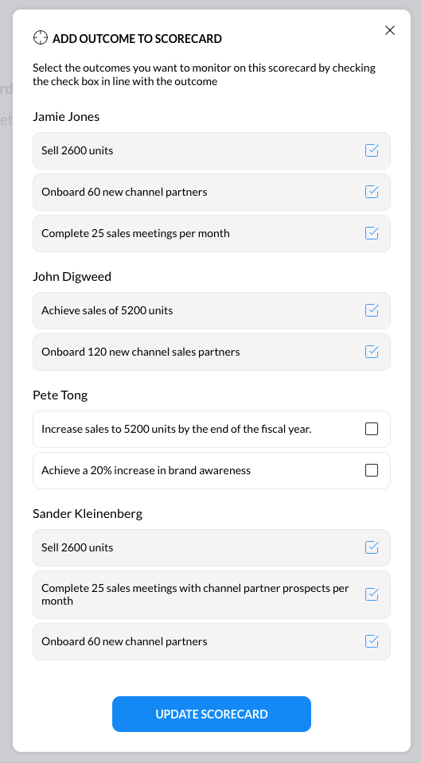Learn how to create a scorecard to monitor performance against forecast metrics and KPIs
Learning outcomes:
What is a scorecard
A scorecard is a performance measurement tool used to track and evaluate the progress of specific outcomes, or key performance indicators (KPIs) over time. It provides a visual representation of the performance data, making it easy to understand and interpret trends and outcomes.
They are intrinsically connected to waypoints. So to create a scorecard, you must first create an outcome that measures the metric you want track.

For example, your sales team have a KPI to complete 25 sales meetings per month in order to meet their sales quota. You could create a scorecard, invite the 2 sales people, and add their outcome that tracks number of monthly sales meetings completed to the scorecard.
How to build a scorecard
To build a scorecard, navigate to scorecards by clicking the Scorecards option under Dashboards on the nav bar on the left of screen.
%20(1)-1.png?width=688&height=516&name=app.waymaker.io_version-test_scorecard_1607302858034x911938104401592300(iPad%20Pro)%20(1)-1.png)
To create a scorecard, click add new scorecard. Give the scorecard a name, add the team and hit save.
To track an outcome, the owner of the outcome must be a member of the scorecard.
%20(1)-2.png?width=688&height=516&name=app.waymaker.io_version-test_scorecard_1607302858034x911938104401592300(iPad%20Pro)%20(1)-2.png)
You can only ever see the scorecards you are a member of.
You can edit a scorecard by clicking the more button in the bottom right-hand corner. To open the scorecard, click on it.
%20(2).png?width=688&height=516&name=app.waymaker.io_version-test_scorecard_1607302858034x911938104401592300(iPad%20Pro)%20(2).png)
With the scorecard open, click choose outcomes to monitor.
%20(2)-1.png?width=688&height=516&name=app.waymaker.io_version-test_scorecard_1607302858034x911938104401592300(iPad%20Pro)%20(2)-1.png) Then, in the pop-up, choose the outcomes you want to track in the scorecard and click update scorecard.
Then, in the pop-up, choose the outcomes you want to track in the scorecard and click update scorecard.

The scroecard will update to include the waypoint tracking chart for each outcome selected.

Clicking on the title of each outcome will open the goal detail page for the outcome's goal.
The charts can be reordered by drag and drop.
Pro tips for using scorecards
By using scorecards to track progress, organizations can streamline performance management, make informed decisions, and continuously improve their operations. Whether it's a project, department, or the entire organization, scorecards provide valuable insights for driving success and achieving long-term goals.
-
Alignment: Scorecards help align the efforts of team members with key metrics. By tracking key metrics and indicators, everyone can understand how their work contributes to the broader objectives.
-
Real-Time Monitoring: Scorecards provide real-time or near-real-time updates on performance metrics, allowing for timely decision-making and early identification of issues or opportunities.
-
Focus on Key Metrics: Scorecards highlight the most critical metrics and KPIs, enabling organizations to focus on what matters most and avoid being overwhelmed by excessive data.
-
Data-Driven Decision Making: By using scorecards, organizations can make data-driven decisions based on objective performance metrics, reducing the reliance on subjective judgments.
-
Continuous Improvement: Regularly reviewing scorecards promotes a culture of continuous improvement. Teams can identify areas for enhancement, set new targets, and refine strategies based on performance insights.
-
Performance Accountability: Scorecards enhance accountability as individuals and teams can track their performance against targets and take ownership of their responsibilities.
-
Benchmarking and Comparisons: Scorecards enable organizations to benchmark their performance against past performance, industry standards, or competitors, facilitating performance evaluations and setting ambitious goals.
-
Transparency and Communication: Scorecards foster transparency by providing a common understanding of performance data among stakeholders. This improves communication and facilitates discussions on progress and challenges.
-
Early Warning System: Scorecards act as an early warning system by flagging deviations from targets. This allows organizations to take corrective actions promptly and avoid potential setbacks.
-
Motivation and Recognition: Scorecards can be used to recognize and celebrate achievements, motivating individuals and teams to maintain high-performance levels.
